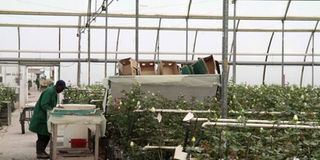Agency roots for Lake Naivasha model for wildlife conservation

A greenhouse at a flower farm in Naivasha, Nakuru County. PHOTO | FILE
What you need to know:
- In a report published on Thursday, the World Wildlife Fund for Nature (WWF) says a model like that of Lake Naivasha’s Integrated Water Resources Action Plan meant to manage the waters of the lake by reducing pollution, can help reverse the dwindling numbers of fish and safe drinking water around the world.
- As it is, humans are now the major influencers on the earth’s future, but the life of all animals is uncertain because humans have been unrelenting in exploiting nature, putting pressure on the survival of other species, some of which feed on humans.
A global wildlife charity says a conservation plan for Lake Naivasha could be one way the world can adopt to prevent possible extinction of certain animal and plant species or even natural resources.
In a report published on Thursday, the World Wildlife Fund for Nature (WWF) says a model like that of Lake Naivasha’s Integrated Water Resources Action Plan meant to manage the waters of the lake by reducing pollution, can help reverse the dwindling numbers of fish and safe drinking water around the world.
The document, The Living Planet Report 2016, is a general warning to the world that we could lose as much as two thirds of wildlife by 2020.
And among the possible causes for this are habitat loss and degradation as more land is cleared for farming, overexploitation of these animals for food or poaching, invasive species like hyacinth and diseases as well as climate change.
The document suggests that we reduce eating proteins to save fish and mammal populations, change to renewable energy and reduce use of chemicals on our farms.
The authors of the report which was based on the Living Planet Index, provided by the Zoological Society of London (ZSL) that tracks the behaviour of 3700 species of animals with backbones since 1970, say we can save these animals especially since they are not yet extinct.
“We are beginning to increasingly understand that a diverse, healthy, resilient and productive natural environment is the foundation for a prosperous, just and safe future for humanity. While environmental degradation continues, there are also unprecedented signs that we are beginning to embrace a “Great Transition” towards an ecologically sustainable future,” says Marco Lambertini, Director General WWF International.
Naivasha, the report says, provides such an example. The region is Kenya’s biggest horticulture hub, employing about half a million people.
Last year, it produced over 122,000 tons of fresh cut flowers worth Sh63 billion, according to the Ministry of Agriculture.
It also has thriving dairy farming and tourism sectors, supported by a national park and geothermal power investments which have already contributed 280MW to the national grid.
This sort-of boom has seen the population rise from 650,000 in 2009 by an annual rate of 13 per cent.
But since the first commercial flower farm arrived here in the 1980s, there have been conflicts between farm owners, pastoralists and environmentalists, some of which have been fatal both to humans and fish in the lake.
The fish were dying as the waters were getting murkier due to pollution from nearby farms.
Pastoralists fought for land rights as small-scale farmers along River Malewa which feeds the lake, demanded unrestricted use of its waters.
But in 2011, these antagonists started to agree on how to manage the waters of Kenya’s second biggest fresh-water lake.
These groups agreed on what they called an “integrated” landscape approach meant to resolve each party’s water use.
As it is, each group has continued to use the water as before, but the plan has meant they use it responsibly.
For example, flower farms are required to continually plant trees and reduce dumping of chemicals into the lake. Smallholder farmers are given cash incentives to plant trees too and avoid farming on river banks.
In fact the Imarisha Lake Naivasha Management Board, which handles this conservation plan, says it has designed a water use allocation system for each group, especially during times of drought.
It may take time for such efforts to bear fruits, but the WWF says the idea goes a long way in sustaining the survival of the human race.
“Population sizes of vertebrate species have, on average, dropped by more than half in little more than 40 years. The data shows an average annual decline of 2 per cent and there is no sign yet that this rate will decrease,” it says.
Fish, reptiles, birds and mammals are all threatened. They have declined in numbers by 58 per cent since 1970.
The report lists elephants as the most affected land mammals whose numbers are falling fast through poaching and habitat loss.
As it is, humans are now the major influencers on the earth’s future, but the life of all animals is uncertain because humans have been unrelenting in exploiting nature, putting pressure on the survival of other species, some of which feed on humans.
“We need to transition to an approach that decouples human and economic development from environmental degradation—perhaps the deepest cultural and behavioural shifts ever experienced by any civilisation,” the report says.





